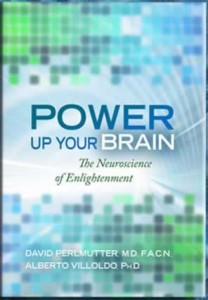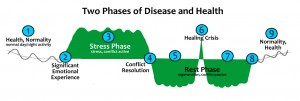
Power Up Your Brain
This past month, I’ve been reading an incredible book called “Power Up Your Brain: The Neuroscience of Enlightenment“ by David Perlmutter, MD, FACN and Alberto Villoldo, PhD. Dr. Perlmutter is a neuroscientist, Dr. Villoldo a shaman. Interesting, to say the least!
This book is full of information that looks at the whole body and the effects of stress and trauma not only on the physical body but on the emotional and mental body. It’s also packed with new discoveries about the brain as more research is being done and dispelling myths.
I would like to go over the information given about the brain’s evolution and how that affects us today. As I read the book, I made notes and I’ll use those notes to write this blog. However, I strongly recommend that you add this book to your reading list because I’ll only be scratching the surface of the information that is given within.
“Anger, fear, jealousy, greed, and worry, while comonplace, undermine our inner peace and sense of worth. But even while … meditating …the mind continues to chase thoughts, compose to-do lists, and fret about activities not yet completed and situations not yet resolved.”
The old brains – reptilian and limbic
Although your brain has unlimited potential, currently it relies on the neural networks created by the prehistoric, survival-at-all-costs brain regions – the reptilian brain and the limbic brain.
The first brain is the reptilian brain, which is anatomically very similar to the brain of modern-day reptiles. This area of the brain is completely instinctual and only concerned with survival (involved in the fight or flight response). It regulates the autonomic functions of breathing, heart rate, digestion and body temperature. It feels no emotions at all.
The second brain is the limbic brain (or mammalian brain) comprised of the amygdala, the hypothalamus and the hippocampus. In the limbic system, signals brought to the brain from the five senses are decoded according to the four F’s – fear, feeding, fighting and fornication. This is the brain of instinct and emotion programmed in us according to the cultural environment we grew up in. Through it we develop behaviours that keep us out of harms way.
The hippocampus acts as a way station, acquiring information from the five senses and sending it out for processing via the amygdala (if there is a perceived threat the amygdala governs our fight-or-flight response) or via the cerebral cortex for all other information. When the hippocampus begins to deteriorate (as a result of free radical damage and oxidative stress from trauma and long-term stress), new experiences are less likely to be stored and remembered (seen in diseases like Alzheimers).
The new brains – neocortex and prefrontal cortex
Luckily, you can overcome the toxic emotions of your old wiring , and the conditioning based on negative experiences from the past. You can heal the old brain and create new neural connections – thereby engaging newer, higher, more evolved brain structures – the neocortex, the prefrontal cortex and the anterior cingulate.
The third brain is the neocortex which is responsible for speech, writing and higher-order thinking in humans. “If we do not need to fear, fight, seduce, or dine with a person we encounter in any particular situation, the thalamus relays the sensory information, colored by the joys, excitements, worries, or concerns of the limbic brain, to the neocortex for reflection and appropriate behaviour.”
“The neocortex processes signals in a holistic fashion, interpreting environmental sights and sounds into coherent messages. . . It is in these higher cortical areas that selfless love, reasoning, and logic take place. This brain allows us to create new ideas and entertain notions such as democracy as well as to understand mathematics, write poetry, compose music and art, dream of freedom and envision the future.”
This brain can think in terms of time and space. It can store food for the winter, mark the turning of the seasons, and plan and recognize future actions and consequences as good and bad, right and wrong. The neocortex can restrain the Four F’s of the limbic brain and is involved in meditative and transcendental experiences.
The Evolution of the Brain and the Mind
“Thousands of years ago, our ancestors faced a neurological opportunity similar to the one we face today, an opportunity that facilitated an evolutionary leap forward. With the awakening of the neocortex, our forebears acquired a new brain structure that nature had wired for joy, creativity and innovation.
To access that potential, our ancestors required specific nutrients to provide fuel to run their neurocomputer. Once they added brain-enriching foods to their diet, the faculties of certain individuals, the visionaries of their day, came online and began to create great works of art, devise written languages, establish civilizations, and lay the foundations for our modern experience.”
DHA (docosahexaenoic acid) found in rich supply in fish and mollusks, is a brain food that has become increasingly scarce in the human diet of today. However DHA provided the neuronutrient boost that brought the prefrontal cortex online.
The prefrontal cortex is associated with personal initiative, invention, science, creative thinking. “When our brain functions synergistically, our prefrontal cortex is fully awakened and we have the ability to develop the very highest form of intelligence and creativity and remain grounded and effective in the world.”
Understanding the conflict between the old brain and new brain
“The old brain perceives the world as a frightening place, filled with rivals competing for the same scarce resurces. To this brain, what matters most is survival, and it is always ready to fight or to flee. It gave rise to the belief that the spirit world is populated with fierce gods who demand sacrifice and that the physical world is prey to invisible forces that are to be appeased. It seeks magical and religious explanations for natural phenomena.”
The new brain, however, understands that we do not have to live in a continuous state of threat – or to be constantly striving for wealth and in constant conflict and competition to justify greed. “It comprehends, rather, that we are all interconnected, that we can practice compassion by ‘turning the other cheek’ . . . and that physical ‘death’ is really an opportunity to return to a heavenly realm.” This higher mind-set calls out to the ways of love.
The most recently developed part of the brain is the anterior cingulate, which mediates empathy, social awareness, intuition, compassion and the ability to regulate emotion. “Its functionality, or lack thereof, helps determine whether our day-to-day behavior is reflexive and fear-motivated or is a manifestation of our uniquely human ability to recognize a wide array of choices, implications, and consequences.” Meditation and other spiritual practices strengthen the anterior cingulate while also calming the primitive amygdala.
It’s interesting, but not surprising to discover that anger produces the opposite effect to meditation. Anger shuts down communication to the prefrontal cortex. Emotion and fear determine and dominate behavior.
“Anger interrupts the functioning of your frontal lobes. Not only do you lose the ability to be rational, you lose the awareness that you’re acting in an irrational way. When your frontal lobes shut down, it is impossible to listen to the other person, let alone feel empathy or compassion . . .”
However, when you intensely and consistently focus on your spiritual values and goals, you increase the blood flow to your frontal lobes and anterior cingulate, which cause the activity in emotional centers of the brain to decrease.
Based on the fact that meditation enhances the functionality and capability of this circuitry, a very important link has been made between the physical brain and spirituality. “We believe that there is a coevolution of spirituality and consciousness, engaging circuits that allow us to envision a benevolent, interconnecting relationship between the universe, God and ourselves.”
Tomorrow, I’ll discuss the role of the mitochondria and how they control the fate of the cell.


